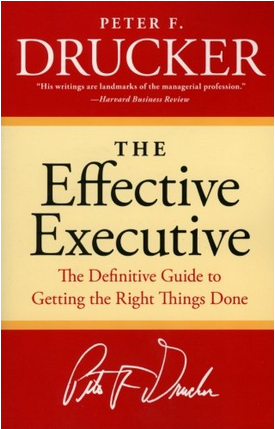This one’s a classic business book by the dean of business thinking.
- Effective executives know where their time goes
- Effective executives focus on results
- Effective executives build on strengths
- Effective executives focus on the 80/20
- Effective executives make effective decision
1. Effective executives know where their time goes
- people can be very time consuming
- be slow to hire and hire only good people
- track your time and prune time wasters
- beware the recurrent crisis b/c these should be foreseeable/preventable
- a well-managed plant is usually quiet and boring
- time-wasters often result from overstaffing
- too many meetings indicate poor organizational structure or employees with the wrong skill set
- consider working from home one day a week or in the morning
2. Effective executives focus on results
- efforts don’t matter, only results matter
- three types of results are: 1) direct production, 2) culture building, 3) employee development
- four requirements of effective workplace: communications, teamwork, self-development, development of others
- effective meetings have a clear purpose that relates directly to the corporate mission
3. Effective executives build on strengths
- promote based on the candidates strengths
- strong people often have strong weaknesses
- identify the right person to fit the role. Rarely change the job to fit the person.
- do not hunt for a genius to do the impossible, redesign the job
- make each job demanding and big
4. Effective executives focus on the 80/20
- this is the secret to success
- do first things first and do one thing at a time
- success is not a sprint, it’s a marathon
- stay lean by discarding anything that’s not working
- always prioritize work based on opportunity not problem
5. Effective executives make effective decisions
- don’t worry about unimportant decisions, worry only about important ones
- if a problem is general, solve it generally and establish a rule
- identify the criteria to determine if the problem is solved
- afterwards, test to see if the problem was solved
- one does not argue with a hypothesis, one tests it
- encourage disagreement because disagreement often leads to alternate solutions
- sometimes decisions are like surgery, the best option is to do nothing
